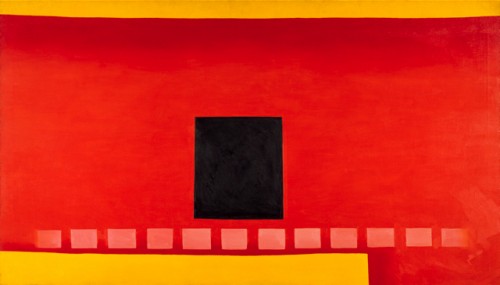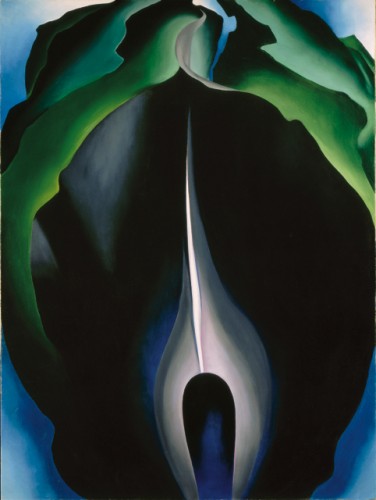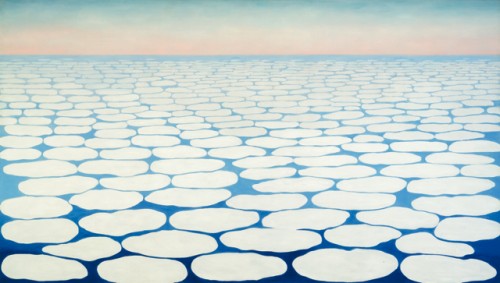
Black Door with Red, 1954. Oil on Canvas, 48 x 48 in. Chrysler Museum of Art, Norfolk, Virginia. Bequest of Walter P. Chrysler, Jr. 89.63 (CR1271). Copyright, Georgia O’Keeffe Museum/Artists Rights Society (ARS), New York.
“Objective painting is not good painting unless it is good in the abstract sense.” – Georgia O’Keeffe, 1976
When discussing abstract art of the 20th-century, the likes of Kandinsky and Matisse are often the works that most easily come to mind. However, the newest exhibition at The Phillips Collection – Georgia O’Keeffe: Abstraction – suggests the need for a potential addition among the abstract ‘authority’.
The historical 100-plus-piece exhibit reveals a side of Georgia O’Keeffe that has previously gone somewhat unrecognized, that is, in comparison to her more popular paintings of flowers, animal bones, and landscapes – subjects that are typically synonymous with the artist. By showcasing all facets of O’Keeffe’s art in one place, the display helps to demonstrate how truly influential abstraction was throughout her career.
In a linear fashion, the exhibition begins by revealing O’Keeffe’s earliest abstractions. Although quite lovely, O’Keeffe’s early works were also somewhat lackluster – resulting from her dedication to Beatrice Irwin’s book The New Science of Color (1915), which encourages artists to focus on gray-tones before incorporating new hues into their paintings. However, once O’Keeffe introduces color into her work through intricate tonal transitions, everything seems to finally come together. Two of my favorite pieces in the collection – Blue I, 1916 and Blue II, 1916 – provide just a sweet taste of what O’Keeffe was capable of and would ultimately master.

Jack-in-the-Pulpit No. IV, 1930. Oil on Canvas, 40 x 30 in. National Gallery of Art, Washington, D.C. Alfred Stieglitz Collection, Bequest of Georgia O’Keeffe, 1987.58.3 (CR 718). Image courtesy of the Board of Trustees, National Gallery of Art, Washington.
By the 1920’s, O’Keeffe’s colorful and bold abstractions acquired widespread praise; however, the artist chose at this time to change her emphasis from abstraction “to redefine herself as a painter of representational forms” – though arguably abstraction remained at the forefront of her work, present, even well after her publicized shift of focus.
The passionate relationship between O’Keeffe and photographer Alfred Stieglitz is also highlighted in conjunction with the collection. Photographs taken by Stieglitz of O’Keeffe’s nude figure demonstrates the intense creative bond that the two shared, but more importantly offers a unique perspective of O’Keeffe’s comfort within her own skin. It was also Stieglitz who can be ‘credited’ with marketing O’Keeffe’s art as manifestations of womanhood, which continues to sometimes trouble the artist’s reputation – simply because O’Keeffe did not entirely welcome such a grounded interpretation of her work.
Unfortunately, to O’Keeffe’s dismay, it is quite difficult to walk through the collection without developing some individual interpretations of her work. I personally took notice to the rendering of sexual experience through works such as Alligator Pears, 1923 and Blue Flower, 1918. Furthermore, on a more humorous level, I noted what seemed to be a portrayal of breakfast a la “eggs over-easy” in the Pelvis Series, Red with Yellow, 1945 – clearly demonstrating my enjoyment for interpreting abstract art, or more simply my impending hunger that morning.

Sky Above Clouds III/Above the Clouds III, 1963. Oil on Canvas, 48 x 84 in. Private Collection (CR 1479). Copyright, Georgia O’Keeffe Museum/Artists Rights Society (ARS), New York.
After moving to New Mexico, O’Keeffe continued towards distilling abstract patterns from the natural world – quickly finding symbolic forms within her new context, the desert. For example, the Pelvis Series, Red with Yellow, 1945 was created as a result of the abstract composition developed by an animal’s pelvis bone framing the sky (clearly I was wrong about the eggs), and Above the Clouds I, 1962/63 used the geometric shapes created by clouds over the mountains from an aerial view as inspiration. Moreover, Black Door with Red, 1954 is actually a representation of patio doors located near O’Keeffe’s home in Abiquiu – the small rectangles represent the stone path, the horizontal band represents the sky, and the large rectangle represents the patio door.
The exhibit concludes with some of O’Keeffe’s final watercolors, such as Untitled (Abstraction Red Wave with Circle), 1979, which were composed by memory – and with the help of an assistant – because of her debilitating disease, making it almost impossible to see the canvas. These final simple strokes, reminiscent of abstract shapes that were so important to O’Keeffe in her earliest works, bring the collection back in full circle. For me, these final pieces were the most inspirational within the collection – representing a love for a passion that only few can hope to achieve in a lifetime.
Georgia O’Keeffe: Abstraction, February 6 – May 9, 2010. The Phillips Collection is located at 1600 21st Street, NW.
Pingback: uberVU - social comments
I really enjoyed this article, Georgia O’Keeffe is one of the artists who has influenced my own art work. I love her abstract pieces. I aspire to be just like her.
Pamela Dunmire, Abstract Artist
Prescott, AZ.
Make an impression on! You truly covered this matter effectively. Are there other assets which i will need to check out out?
Your commentary are fairly advised and helpful. Have you regarded composing professionally? Like a periodical or some thing?
It seems like you’re creating problems yourself by seeking to solve this issue instead of shopping at why their is usually a problem in the first place. many thanks !! really useful publish!
Truly remarkable !! I have just ordered a mobile app development at codingate, they quickly determined true severe and greater than affordable developpers who developed the point in couple of a short time!!cellular – telecom and voip – internet – desktop applications .
Your website looks actually beneficial. Being a webpage writer myself, I definitely appreciate the time you took in writing this article.
Fantastic web page. Beneficial knowledge
Wonderful web site. Keep undertaking.
Intriguing web site. My co-workers and I were just discussing this another evening. Also your page seems exceptional on my old sidekick. Now thats uncommon. Decent do the job.
Pingback: Georgia O’Keeffe, Extended Hours » We Love DC
I love the femininity of Georgia O’Keeffe’s artworks. When I was studying years ago I was concentrating on masculine works by Pollack and Rothko, but on encountering O’Keeffe’s work I was intrigued by her stylised imagery. I was studdying photography at the time and I was struck by how similar the natural still lifes of Edward Weston were so similar in power to Georgia O’Keeffe. Jack-in-the-Pulpit No. IV is a perfect case in point.